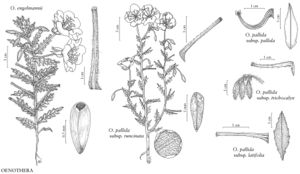Oenothera pallida subsp. pallida
Herbs perennial, usually glabrous, sometimes strigillose, rarely sparsely villous; from a taproot, lateral roots producing adventitious shoots. Stems usually branched throughout. Leaves: rosette not present at anthesis, 2–6 × 0.3–0.8 (–1) cm; blade lanceolate to linear-lanceolate or oblong, margins usually subentireor remotely denticulate, rarely pinnatifid, usually repand. Flowers: buds with free tips 0.5–2 mm; floral-tube 20–35 mm; sepals 12–18 mm; petals 12–25 mm. Capsules spreading, contorted to curved. 2n = 14.
Phenology: Flowering May–Sep.
Habitat: Sandy soil, dunes, disturbed areas, alkaline soil.
Elevation: 1100–2000 m.
Distribution
B.C., Ariz., Colo., Idaho, Nev., N.Mex., Oreg., Utah, Wash., Wyo.
Discussion
The distribution of subsp. pallida centers in the intermountain region from Oregon and Washington east of the mountains, adjacent southern British Columbia, south through southern Idaho, Wyoming, western half of Utah, southern Nevada, to northern Arizona, northwestern New Mexico, and adjacent southwestern Colorado. There are morphological intermediates with subspp. runcinata and trichocalyx. Densely strigillose plants occur within the range of subsp. pallida, especially near the St. Anthony Dunes in Idaho, and have been referred to as var. idahoensis.
Baumannia douglasiana Spach is an illegitimate name that pertains here.
Selected References
None.
